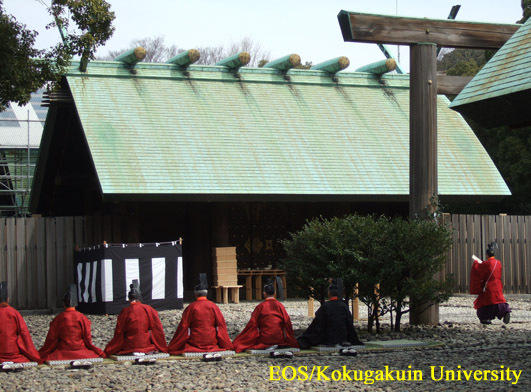- トップ
- Encyclopedia of Shinto
- Kinensai
Encyclopedia of Shinto
| Main Menu: | |
| Links: |
詳細表示 (Complete Article)
| カテゴリー1: | 5. Rites and Festivals |
|---|---|
| カテゴリー2: | State Rites |
| Title | Kinensai |
| Text | A regular observance of the Ritsuryō state, also called toshigoi no matsuri. It ranks alongside the Tsukinamisai (in the sixth and twelfth months) and the Niinamesai (in the eleventh month) as one of the most important observances of the time, as shown by the relatively large amount of imperial tribute (heihaku) offered on its occasion. It was celebrated annually on the fourth day of the second month to pray for a bountiful harvest. Whereas the governance of Shinto affairs by the Ritsuryō state generally concerned only the "imperially administered shrines," all the 3,132 shrines recorded in the Jinmyochō (a list of all shrines receiving official patronage either from the imperial or the provincial authorities) were required to perform the Kinensai. It is now believed that Emperor Tenmu established the Kinensai in 675 as a rite of the Ritsuryō state, modeling it on a spring field-sowing rite widely observed in China. In 798, a distinction was introduced between Imperially-endowed/administered shrines ("Jingikan saijin" or kanpeisha) and Provincially-endowed shrines ("kokushi saiki nenshi" or kokuheisha,), as well as between large and small shrines of each of these categories. The rite itself, as performed at the Jingikan saijin, consisted of two parts: presentation of a norito and presentation of tribute (hanpei gyōji). Although the emperor himself does not appear to have taken part in the ceremony, it was attended by the main officials of the Jingikan, as well as Council of State officials such as the daijin, sangi, ben, and geki, and the hafuribe (who travelled to the capital to receive heihaku tribute). In the Heian period, as the hafuribe ceased to participate and the officials became negligent, the Kinensai became a mere formality and came to be celebrated solely within the Jingikan. Beginning around the middle of the Heian period, the replacement of the kami enshrined at each of the 3,132 participating shrines as the ceremony's object of worship with Amaterasu Ōmikami lent Kinensai a much greater solemnity. During the period of "cloistered emperors" insei (roughly 1072-1287), the Kinensai continued to increase in importance, eventually turning into a rite performed by the emperor himself to honor Amaterasu. It eventually became such a sacred ceremony that the court ritual would be cancelled in case of any pollution at the Ise Shrines, in which case even the dispatch of a provisional imperial emissary to Ise would be suspended. During the early Kamakura period, Emperor Juntoku's Kinpishō mentions the above arguments when clearly stating that Kinensai was a ritual of the Ise Shrines. Like other palace rituals, Kinensai died out at the end of the Muromachi period as a result of military conflict. Thereafter, it was only preserved in an abbreviated, irregular form called sairō by the Shirakawa house, which had inherited the position of head of the Jingikan. Although there was an unsuccessful attempt to revive Kinensai in the waning years of the seventeenth century (1688-1704), the observance was not reintroduced until the Meiji period, in 1869. — Fujimori Kaoru |





